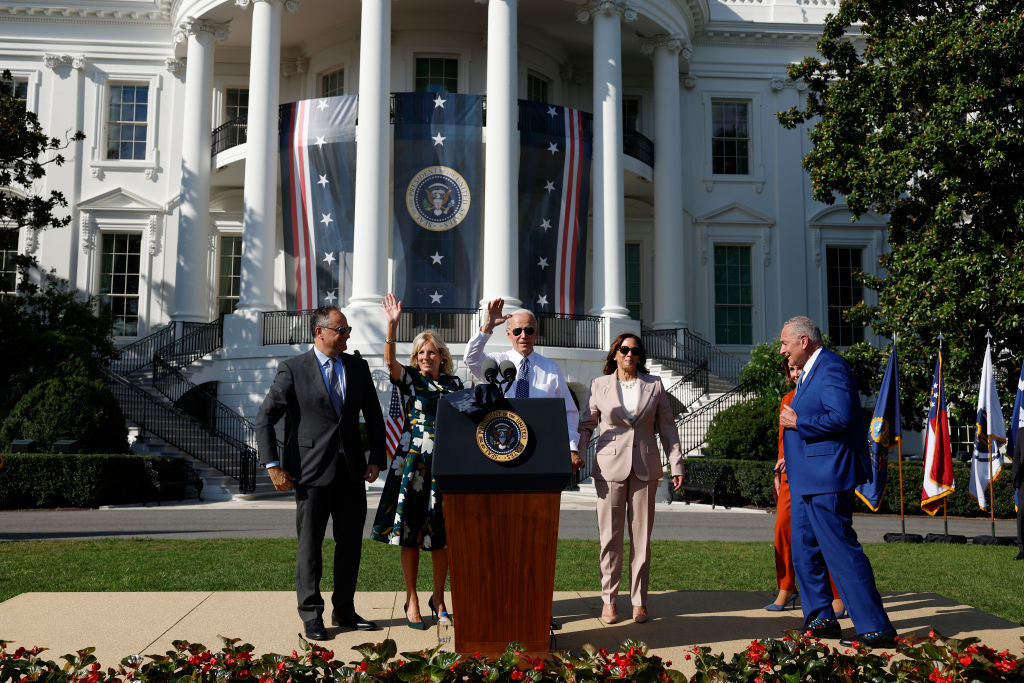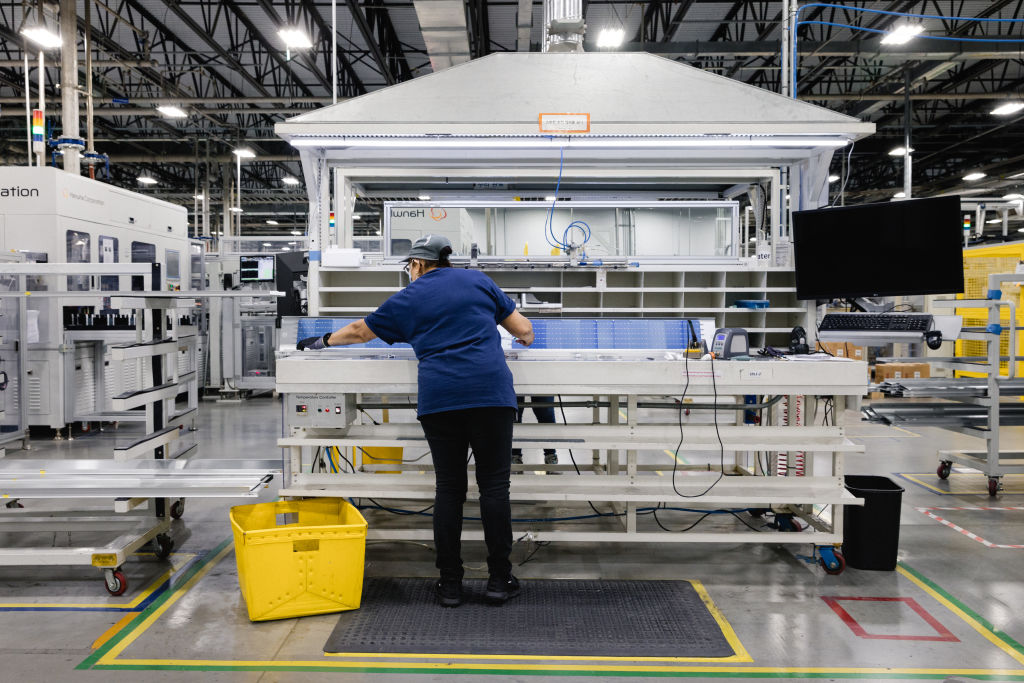(To get this story in your inbox, subscribe to the TIME CO2 Leadership Report newsletter here.)
In late July, I visited a steel mill in Gallatin, Ky., operated by the company Nucor. During my visit, I watched as the facility churned out massive rolls of low-carbon steel destined for use in renewable infrastructure. Nucor’s stock price has increased nearly five-fold in the last three years, and the day before I visited the company had announced blockbuster profits citing, in large part, all the demand created by businesses racing to take advantage of money flowing from federal spending programs, including and especially the Inflation Reduction Act (IRA).
Kentucky is far from alone. Across the country, the IRA has spurred hundreds of billions of dollars in investment in clean technology. Lithium-ion battery makers are opening factories near auto industry hubs to serve the growing electric vehicle market. Solar manufacturers are setting up shop in red states like Georgia. And old-school oil companies are investing in hydrogen. “It's a transformation of the economy,” says John Podesta, President Joe Biden’s senior advisor charged with implementing the IRA.
The IRA, which will mark one year since its signing on Aug. 16, is a classic piece of D.C. lawmaking. It came about in a windy legislative process that began with a big campaign promise from Biden and ended with backroom deal-making on Capitol Hill. And it has an odd, misleading name with a funny acronym, to boot.
More From TIME
But while the law was born in D.C., to understand its impact you need to look outside the capital as it reshapes industry across the country and the world. From Miami to Mumbai, Boise to Brussels, wherever I’ve traveled in the last year, the IRA has been top of mind for policymakers, business leaders, and civil society. It will not only determine whether the U.S. meets its emissions reduction goals, but also shape the global economy for decades to come.
“I want to make it clear: the Inflation Reduction Act is the single most important climate action since the Paris Agreement in 2015,” Fatih Birol, the executive director of the International Energy Agency, told me in May.
‘Quick and immediate’
At the core of the IRA is a mantra oft-repeated by members of the Biden Administration: the law is designed to be private sector-led and government-enabled. Instead of introducing mandates, the IRA offers tax breaks to companies that deploy clean technologies.
The impact was swift. “It was quick, it was immediate, and it doesn't appear to be slowing down,” says Greg Matlock, who leads EY’s Americas Energy Transition practice. Matlock says that “within a week” of the law’s passage he noticed “tangible movement on investments” from clients.

Companies have invested more than $270 billion in U.S.-based clean energy projects—think wind, solar, and battery—since the IRA became law, according to a report from the American Clean Power Association released earlier this week. Electric vehicle technology investment has totalled more than $130 billion, according to White House data. And the private sector is expected to spend trillions more to take advantage of the incentives in the law over the next decade. “People are deploying capital because of the IRA. If you talk to anyone in the finance world, where people are seeing uptake in capital formation is in the clean sectors,” says Podesta. “And there's no question that the bill itself has spurred this.”
The IRA has also convinced some longtime skeptics of the clean energy transition about the opportunity to make money with lower-carbon solutions. Even as oil and gas companies double down on their commitment to fossil fuels, for example, they have also allocated billions in the past year to pursue technologies like hydrogen and carbon capture that can take advantage of federal subsidies. ExxonMobil is even exploring getting into the lithium game, hoping to exploit its knowledge of drilling to make money off the transition.
Read more: The IRA Is Our Best Shot at Tackling Climate Change—But Only If We Don't Squander It
The movement on big, capital-intensive projects in manufacturing and the power sector is easiest to see. But forward thinkers in other industries are also considering how IRA incentives can help their bottomline, from tax deductions for energy efficiency in retail space to tax credits for electrifying fleet vehicles. In April, I participated in a discussion with local business leaders in Milwaukee who were all clamoring to learn how their companies could take advantage of the IRA incentives. “Fuel cells, solar, heat pumps, clean vehicles, vehicle charging—there’s something in there for everybody,” said Chuck McGinnis, a vice president at Johnson Controls, a conglomerate that makes HVAC among other things, at the event.
All of this enthusiasm means that the federal government may end up spending a lot more on the law’s clean-energy incentives than originally thought. Prior to the law’s passing, Congressional backers citing the Congressional Budget Office and Joint Committee on Taxation estimated that the federal government would spend close to $400 billion on the law’s climate provisions. A paper published in March by the Brookings Institution estimated that it could top $1 trillion as companies and consumers take advantage of the law’s uncapped tax incentives.
A critic of the law might balk at the extra cost to the taxpayer, but there’s another way to look at it: higher uptake means the law is working.
‘Good jobs’
In late June, top officials from the Biden Administration fanned out across the country to make the case to the American public that the IRA and other policies are creating jobs and reinvigorating communities. They were armed with good news: a report from the Department of Energy showed that the U.S. added 114,000 clean energy jobs last year. Energy Secretary Jennifer Granholm visited a burgeoning corridor of electric vehicle manufacturing in the southeast that’s become known as the “battery belt,” for example, and Environmental Protection Agency Administrator Michael Regan traveled to Vermont to announce a new $7 billion grant program to provide solar power to low-income households.
“What we're going to do is go out and tell the story,” says Podesta.
The cable news airwaves may be relatively quiet about the IRA, yet the trillions in investment catalyzed by it have undoubtedly begun to shape politics in the U.S. IRA supporters love to talk about green jobs in red states, particularly in the emerging “battery belt.” Manufacturers of batteries as well as EVs, solar panels, and other technologies have clustered in red states like Kentucky, Tennessee, and Georgia, leading even some Republican officials, like Trump-aligned GOP Rep. Majorie Taylor Greene, to embrace clean energy when the components are being built in their backyard.

But beneath the surface the narrative gets more complicated. Many states winning the race for clean energy investment—think of say Georgia or Tennessee—appeal to companies in part because of their “business friendly” approach. That includes offering tax incentives to attract companies as well as laws that make it more difficult to form unions. The fast pace of the transition—particularly for automakers—has already raised concerns among workers. Ensuring that jobs created by clean energy investment are what Biden has called “good jobs” will be a continuing thread in the coming years.
Whatever wrinkles that need to be sorted out haven't stopped officials in red and blue states alike from clamoring for dollars from the law. Beyond the private sector investment, the law funds everything from climate resilience to environmental justice—and cities and states have an important role to play in implementing it.
In Boise in April, I attended a dinner with Mayor Lauren McLean who said the law can help the city achieve its goal of running its facilities on 100% clean electricity. “We’re blessed by funding from the Inflation Reduction Act,” she said. “It’s allowing me to advance priorities that we had faster.”
Going Global
For all the complexity of domestic politics, the international dynamics may be even more complicated. The law will inevitably help bring down emissions, a win that nearly everyone can get behind. But it favors American industry, something that allies and competitors alike aren’t too happy about.
The European Union, in particular, went through stages of reaction. First, officials were excited that the U.S. had finally passed a big climate law. Then, upon reading the details, they were outraged by the support for domestic industry. And, finally, they came to accept that the law just meant that the E.U. would need to do more to encourage its own industry. “Any policy you devise… like the IRA right now, has the potential of creating tensions because you’re taking things in a different direction, which was not envisaged when you entered into trade agreements,” Frans Timmermans, executive vice-president of the European Commission, told me last September.
A few months later, Amitabh Kant, the Indian official charged with leading this year’s G20 summit in India, brought up the IRA before I could even turn to it when we met at his office in Delhi. He told me it was “the most protectionist act ever drafted in the world” and said that its incentives had already stung the nascent Indian hydrogen industry. “You believed in market forces and now you do this?” he told me of his message to U.S. officials.
The uproar has quieted since then. That’s in part because other countries have little recourse to push back, but it’s also the result of a common concern over China. Over the last decade, the country has built out a domestic clean energy supply chain, and now controls production of many necessary products that countries around the world—including the U.S. and in Europe—rely on for green investments. The IRA contributed to a reckoning with this dependency, and now places like the E.U. and India are following in the footsteps of the IRA to finance a buildout of their own domestic industries.
“We spent a lot of time talking to our trading partners,” Podesta says. Now, “we're working with our friends and allies to create secure supply chains and friendly supply chains rather than fighting about specific provisions of the IRA.”
Regardless of the political and economic wrangling around it, the IRA will ultimately need to be judged on how well it brings down emissions. Analysis from the Rhodium Group shows that with the IRA, complemented by other climate policies on the books, U.S. emissions will decline somewhere between 29% and 42% by 2030 from 2005 levels.
There’s a significant difference between those two percentages. Some of the factors at play—think of oil prices and economic growth—will be difficult for any political leader or even single government to shape. But other factors, including whether the U.S. can sort out the mess of permitting to get clean energy projects out faster, remain live issues that can be addressed with policy.
One of the biggest questions that comes up on the road, especially outside the U.S., is whether the IRA would survive a future Republican administration and the whiplash that would accompany it. There's no question that a future Republican president might succeed at chipping away at the law around the edges, but early indicators suggest that, at its core, the law is here to stay.
Earlier this year, a contingent of Republicans whose districts are benefiting from clean energy investments pushed back when House Republicans proposed gutting the law as part of budget negotiations. Podesta likens it to the Affordable Care Act, the law passed under President Barack Obama that Republicans tried and failed to repeal: "Once these plants are built, once these jobs are created, it's going to be hard to reverse that."
More Must-Reads from TIME
- Why Trump’s Message Worked on Latino Men
- What Trump’s Win Could Mean for Housing
- The 100 Must-Read Books of 2024
- Sleep Doctors Share the 1 Tip That’s Changed Their Lives
- Column: Let’s Bring Back Romance
- What It’s Like to Have Long COVID As a Kid
- FX’s Say Nothing Is the Must-Watch Political Thriller of 2024
- Merle Bombardieri Is Helping People Make the Baby Decision
Write to Justin Worland at justin.worland@time.com
